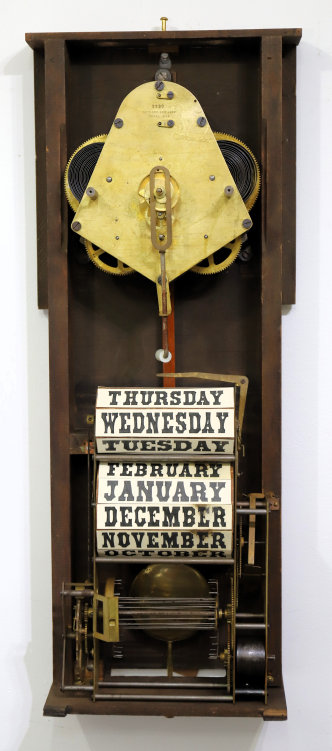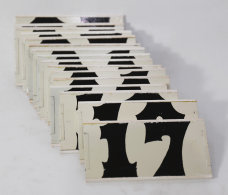
164. $600
Prentiss Clock Improvement Co. “Empire with Calendar”, 1891-1900. This
is a remarkable clock: The refinished walnut case is 38 inches long and lifts off the backboard to allow access to the two movements
that wind separately – the time movement, which runs 30, 60, or 90 days depending on the springs installed, and the calendar movement
that winds on the bottom right when you remove the case cover (it hooks at the top and lifts off). The calendar spring
is huge and, given that it unwinds slightly only once a day, will probably never have to be wound. When you do it will take a
large key. As with other calendar clocks, there is a cam at the top behind the dial that rotates with the hour hand; the
first time around it sets itself to trigger the calendar on the subsequent rotation (every 24 hours). As the lever falls off
the cam the rod drops and strikes the calendar arm, which releases the calendar to advance the day, month (when appropriate), and
date. The mechanism is working properly and the day and month advance, but the cards for the date do not fit and will jam
the mechanism. I do not believe these are the proper cards for this calendar; they may have been made for a different Prentiss
clock, as they do fit onto the card pins. A previous owner removed the cards and placed a manufacturer card in the date window. You can make cards to fit if you are so inclined; you might refer to a previous AAC sale. The time movement is driven by two
huge springs that can run for up to 90 days. I do not know how long this clock will run, but I wound the springs (one arbor
winds both) more turns than I could count and there was still plenty of spring left. I quit at that point. The
clock is running, regulated by a long pendulum with a damascened bob behind the movement. The dial is painted and signed
and may be original; it has a few chips at the screw mounts and is yellowed. The hands appear to be original. The
dial glass is modern, the three calendar windows are likely original. The day and date labels are likely replacements. You can access the pendulum from a drop-down door in the base. AAC sold an oak version a year ago for $860. $600–$800.



Antique American Clocks JANUARY 2024





